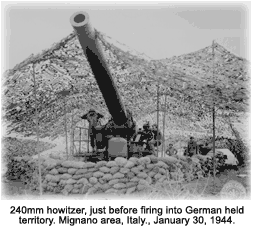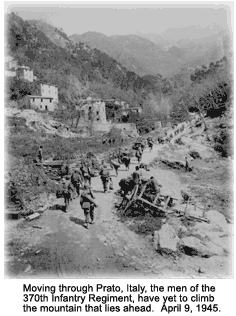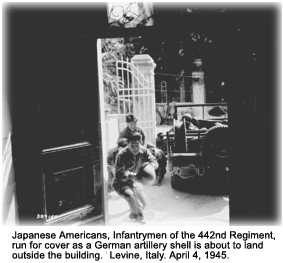The Italian Campaign of World War II was the name of the Allied operations in and around Italy from 1943 to the end of the war. Following victory in the North African Campaign, there was disagreement among the Allies on the next step they should take. The decision to invade Italy was made in January 1943 at the Casablanca Conference — the first war conference between the Allied powers — held in Casablanca, Morocco. The conference between Roosevelt and Churchill took steps toward planning the Allied strategy and the end of the war. It also established terms of unconditional surrender. In a radio broadcast to the American people on February 12, 1943, Roosevelt made clear that he was:
... that the only terms on which we shall deal with any Axis goverment or any Axis fations are the terms proclaimed at Casablanca: "Unconditional surrender." In our uncompromising policy we mean no harm to the common people of the Axis nations. But we do mean to impose punishment and retribution in full upon their guilty, barbaric leaders.
 The Italian Campaign placed Allied troops on the European mainland for the first time, but it was never intended as a substitute for an attack aimed at Germany by way of the more open route through northern France. The invasion of Italy had several lesser objectives, to:
The Italian Campaign placed Allied troops on the European mainland for the first time, but it was never intended as a substitute for an attack aimed at Germany by way of the more open route through northern France. The invasion of Italy had several lesser objectives, to:
 Given the realization that the invasion of France would be impossible in 1943, it was decided to use the soldiers from the recently won North African Campaign to invade the Italian island of Sicily. The goal was to remove the island as a base for Axis shipping and aircraft, allowing free passage to Allied ships in the Mediterranean Sea, as well as putting pressure on the Italian regime to pull out of the war. A combined British-American invasion of Sicily began on July 10, 1943, with seaborne and airborne landings. The Germans were unable to prevent the Allied capture of the island, but they did succeed in evacuating most of their troops to the mainland, the last leaving on August 17, 1943.
The American forces that fought in Sicily were far more sophisticated than those that had gone into battle in North Africa. New landing craft, some capable of bearing tanks, had made getting ashore much quicker and surer. In addition, new amphibious trucks eased the problem of supply over the beaches. Commanders also were alert to avoid a mistake often made in North Africa of parceling out divisions in small increments.
British forces landed on the "toe" of Italy on September 3, 1943. The Italian government surrendered almost immediately, but German forces had prepared to fight without their assistance. American forces landed at Salerno and additional British forces at Tarnato. While the rough terrain prevented fast movement and proved ideal for defense, the Allies continued to push the Germans northward throughout the rest of the year.
The southernmost German defensive line, which was a series of military fortifications in Italy, ran across the country from where the Garigliano River flows into the Tyrrhenian Sea in the west, through the Apennine Mountains to the mouth of the Sangro River on the Adriatic Sea in the east. Called the Winter Line, it was the strongest German defensive line south of Rome, and was fortified with gun pits, concrete bunkers, machine-gun emplacements, and minefields. The western part of the line, which was centered around the historic Monte Cassino monastery, was called the Gustav Line. Those defensive lines proved to be major obstacles to the Allies.
The Battle of Monte Cassino was a series of four battles that began on January 4, 1944. The battles were fought with the intention of breaking through the Gustav Line to seize Rome. Monte Cassino was finally captured in May 1944, which allowed the British and American divisions to begin their advance on Rome, whose capture finally came to fruition just two days before the Normandy invasion.
The focus of the Allied war against Germany shifted to France, and with the shift came a gradual diminution of Allied strength in Italy. Allied forces reached Germany`s last line of defense in the Northern Apennines, called the Gothic Line.
Given the realization that the invasion of France would be impossible in 1943, it was decided to use the soldiers from the recently won North African Campaign to invade the Italian island of Sicily. The goal was to remove the island as a base for Axis shipping and aircraft, allowing free passage to Allied ships in the Mediterranean Sea, as well as putting pressure on the Italian regime to pull out of the war. A combined British-American invasion of Sicily began on July 10, 1943, with seaborne and airborne landings. The Germans were unable to prevent the Allied capture of the island, but they did succeed in evacuating most of their troops to the mainland, the last leaving on August 17, 1943.
The American forces that fought in Sicily were far more sophisticated than those that had gone into battle in North Africa. New landing craft, some capable of bearing tanks, had made getting ashore much quicker and surer. In addition, new amphibious trucks eased the problem of supply over the beaches. Commanders also were alert to avoid a mistake often made in North Africa of parceling out divisions in small increments.
British forces landed on the "toe" of Italy on September 3, 1943. The Italian government surrendered almost immediately, but German forces had prepared to fight without their assistance. American forces landed at Salerno and additional British forces at Tarnato. While the rough terrain prevented fast movement and proved ideal for defense, the Allies continued to push the Germans northward throughout the rest of the year.
The southernmost German defensive line, which was a series of military fortifications in Italy, ran across the country from where the Garigliano River flows into the Tyrrhenian Sea in the west, through the Apennine Mountains to the mouth of the Sangro River on the Adriatic Sea in the east. Called the Winter Line, it was the strongest German defensive line south of Rome, and was fortified with gun pits, concrete bunkers, machine-gun emplacements, and minefields. The western part of the line, which was centered around the historic Monte Cassino monastery, was called the Gustav Line. Those defensive lines proved to be major obstacles to the Allies.
The Battle of Monte Cassino was a series of four battles that began on January 4, 1944. The battles were fought with the intention of breaking through the Gustav Line to seize Rome. Monte Cassino was finally captured in May 1944, which allowed the British and American divisions to begin their advance on Rome, whose capture finally came to fruition just two days before the Normandy invasion.
The focus of the Allied war against Germany shifted to France, and with the shift came a gradual diminution of Allied strength in Italy. Allied forces reached Germany`s last line of defense in the Northern Apennines, called the Gothic Line.
 In the spring of 1945 Allied forces penetrated that final German defensive line to enter the fertile plains of the Po River valley. On May 2, the Germans in Italy surrendered.
Less generally acclaimed than other phases of World War II, the campaign in Italy nevertheless played a vital role in the overall conduct of the war. The Italian campaign involved some of the hardest fighting in the war and cost the United States forces some 114,000 casualties. But the campaign was important in determining the eventual outcome of the war, since the Allies engaged German forces that could possibly have upset the balance in France.
In the spring of 1945 Allied forces penetrated that final German defensive line to enter the fertile plains of the Po River valley. On May 2, the Germans in Italy surrendered.
Less generally acclaimed than other phases of World War II, the campaign in Italy nevertheless played a vital role in the overall conduct of the war. The Italian campaign involved some of the hardest fighting in the war and cost the United States forces some 114,000 casualties. But the campaign was important in determining the eventual outcome of the war, since the Allies engaged German forces that could possibly have upset the balance in France.